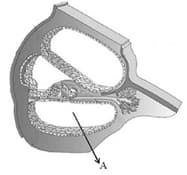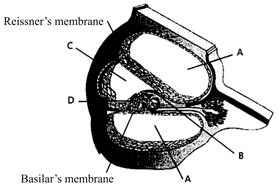EASY
Earn 100
Even in complete darkness. We are able to maintain posture and equilibrium of our body with the help of
(a)Organ of Corti
(b)Vestibular apparatus
(c)Cochlea
(d)Scala tympani
50% studentsanswered this correctly
Important Questions on Neural Control and Coordination
MEDIUM
Match the following columns and select the correct option.
| Column-I | Column-II | ||
| (a) | Organ of Corti | (i) | Connects middle ear and pharynx |
| (b) | Cochlea | (ii) | Coiled part of the labyrinth |
| (c) | Eustachian tube | (iii) | Attached to the oval window |
| (d) | Stapes | (iv) | Located on the basilar membrane |
EASY
In mammals, quadrate is modified as
EASY
Write any two diseases/defects of the ear.
MEDIUM
A gymnast is able to balance his body upside down even in the total darkness because of:
EASY
The sequence of ear ossicles starting from the eardrum is:
EASY
Eustachian canal connects
EASY
Identify the correct sequence of organs/regions in the organisation of the human ear as an auditory mechanoreceptor organ.
MEDIUM
Organ of corti is located on the _________
EASY
Human ear ossicles are
EASY
Select the odd one w.r.t. vestibular apparatus
MEDIUM
Meniere's disease is associated with
EASY

Read the following statements regarding structure marked as 'A' and find out the correct one-
EASY
Auditory sense organ in man is:
MEDIUM
Given below is a diagrammatic cross-section of a single loop of the human cochlea.

Which one of the following options correctly represents the name of three different parts?
EASY
Middle ear of human ears does not contain
EASY
Carotid labyrinth contains
EASY
Structure which does not participate in hearing is
MEDIUM
Schneiderian and tympanic membranes respectively belongs to
MEDIUM
Otitis media (inflammation of middle ear) is caused by
MEDIUM
Otosclerosis is a disease of the _____ (ear/eye).

